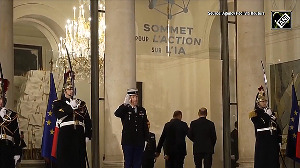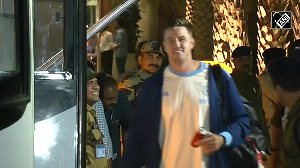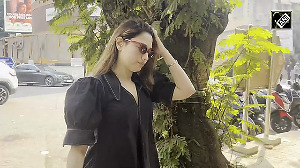A major thrust of the reform of indirect taxes in India in the last two decades has been to move the tax system towards a regime of value-added tax as the principal instrument of taxing domestic trade and consumption at both levels of government--the Centre and the states.
This was felt necessary to attune the tax structure of the country to the requirements of an open economy and recoup the revenue loss from lowering customs tariffs.
At the central level, initiatives were taken in the late eighties to recast the Union excises in the VAT mould by moving in the direction of a manufacturers' VAT called MODVAT.
Introduced first with a somewhat restrictive application, the operation of MODVAT was subsequently universalised and central excises came to be christened as CENVAT with a basic rate of 16 per cent. The infirmity arising from the exclusion of services from the base was sought to be addressed with a tax on selected services with gradually expanding coverage.
To complement the reforms of the central taxes, initiatives were taken to persuade the states also to replace their complex and archaic sales taxes with a destination-based VAT. After deliberating for over a decade, the majority of the states have now moved over to a system of VAT in place of their sales taxes.
The rates, which were many earlier, have been compressed basically into two--12.5 and 4 per cent--and appendages like turnover tax and surcharge and additional sales tax that were in vogue so long have been removed.
The tax on interstate sales--the central sales tax--is also in the process of being eased out so that the tax on domestic sales levied by the states gets transformed into a truly destination-based VAT that causes no impediment to the functioning of the common market.
Tax reformers can surely take credit for what has been achieved. There are, however, a few anomalies and irrational elements in the system that need attention. First of all, the transformation of Union excises into CENVAT has been carried out through rules framed under the Central Excises Act and so formally CENVAT remains "excise", i.e. a tax on production or manufacture of goods minus its cascading features.
It encounters all the problems and limitations such as definition of "manufacturing", determination of assessable value, and so on. While many of the issues have got settled though judicial rulings, the shortcomings of a tax on manufacturing persist.
The scope for manipulation in the matter of taxable value has been sought to be reduced by requiring MRP to be adopted wherever available, but since it is still a tax on manufacturing, abatements have to be allowed to take out the post-manufacture value additions.
But that cannot take care of all situations. In any case, the value added at the subsequent stages of sale remains outside the tax base. Secondly, contrary to the tenets of a good VAT not all commodities are in the tax base or taxed at a uniform rate.
Petrol and diesel are largely outside the CENVAT credit scheme as inputs and so are tobacco products. The rates of tax for both are fairly high. Then there is a plethora of exemptions and concessions. On some commodities, in addition to basic duty there are "special excise duty", "additional duty", "special additional duty", and, in some cases, "additional duty of excise (goods of special importance)".
Of course, there can be a case for levying excises on items like petrol and tobacco at high rates on several grounds apart from revenue, such as environmental protection, discouraging consumption of harmful substances, recovering cost from users as in the case of roads, etc.
Because of its uses for serving these objectives, besides fetching handsome revenue, excise taxes continue to be levied in the European Union and some other countries on top of VAT and of late there has been a resurgence of interest in excise taxes in the professional literature (vide Theory and Practice of Excise Taxation, edited by Sijbren Cnossen).
In a way, one may say, our CENVAT operates as a general tax on commodities produced in India while excises in the conventional sense apply to only a few products like some of the petroleum items and tobacco. However, as noted earlier, the authority for levying CENVAT is derived from the central excise law and so it remains "excise" with all its limitations.
In reforming domestic trade taxation at the Centre, the rational course would have been to go in for a full-fledged VAT, extending to the retail or at least wholesale stage and applicable universally with a single rate covering both goods and services.
That would help to cure the infirmities associated with taxation of manufacturing and also to integrate services in the tax base. Such integration has become imperative with the advent of modern technology and the line between goods and services becoming thin.
That, however, would call for taking CENVAT out of the excise fold and implementing central VAT through a separate law. Understandably, such a radical reform was not possible to push in the early stages. It is, however, time to take stock and move forward.
The state VATs now in operation are also marked by several anomalies and shortcomings. The base does not include services.
Allowing industrial inputs to be taxed at the reduced rate of 4 per cent, as is the case, now violates a basic tenet of VAT and negates one of its main virtues, viz. doing away with the need to distinguish between inputs and final products. As in CENVAT, petrol and diesel are left out of the state VATs and suffer taxation under a separate schedule or under the sales tax laws as before.
Alcohol and narcotics, for which the tax powers belong to the states, are taxed outside VAT and in some states come under state excises. Then there are several other taxes on goods and services at the state level that continue even after the introduction of VAT, e.g. entry tax, luxury tax, and consumption tax.
Thus, the indirect tax field still remains a jungle. Only a unified VAT in the shape of a goods and services tax, as envisioned by the Kelkar Task Force, can clean it up. Excises may be levied selectively on top of VAT. Given some co-ordination, such a tax can be implemented in parallel at both levels of government.
Even though it looks challenging and may require some change in the constitution, reforms of the indirect taxes will not be complete otherwise.







 © 2025
© 2025